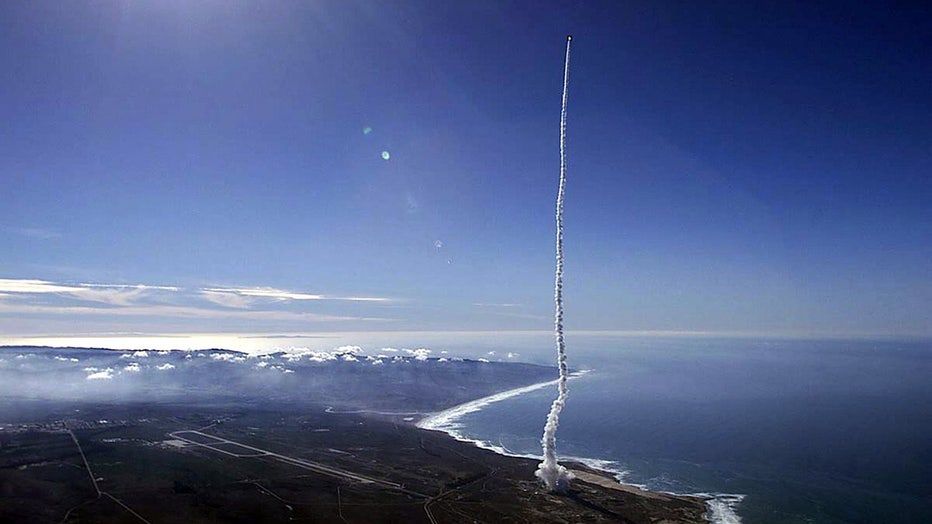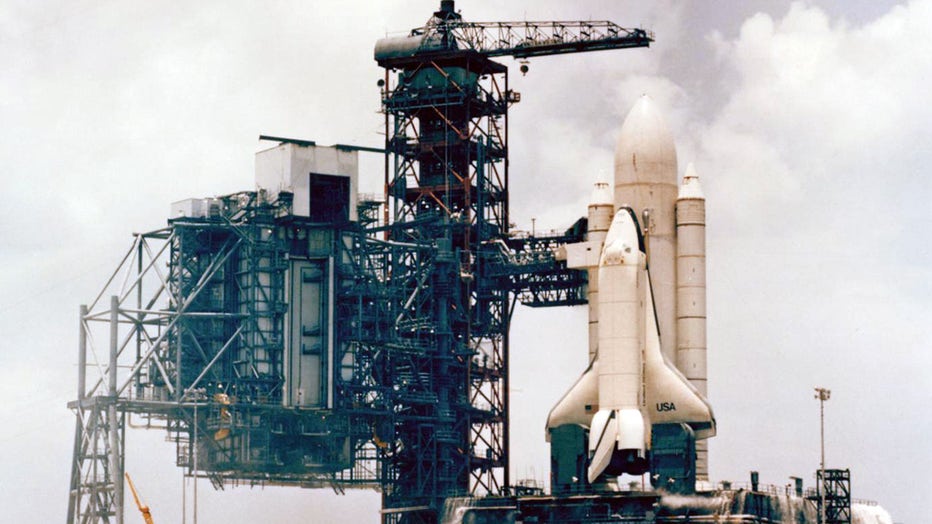The only other time a space shuttle was stacked in California

A view of the Enterprise on the SLC-6 launch tower as it would appear prior to launch, February 1985. (U.S. Air Force photo / Tech. Sgt. James Pearson)
LOS ANGELES - Space shuttle Endeavour was moved to its permanent retirement home late Tuesday. The 120-foot-long orbiter, clad in protective white film, was slowly hoisted to its vertical display position for mating with an orange external tank and white boosters – a precise operation known in the shuttle’s flying days as "stacking."
The process was completed hundreds of times over the course of the 30-year shuttle program, but always in Florida’s cavernous seaside Vehicle Assembly Building, where the shuttle was prepped and launched – always, that is, except for one time.
West Coast shuttle launch plan
When the space shuttle program was initially developed, NASA expected to fly dozens of missions per year, not just from Kennedy Space Center in Florida, but also from a launch site on the West Coast: Vandenberg Air Force Base.
NASA hoped the addition of a second launch site would make it easier to keep a high launch rate going, but more importantly, it would allow the shuttle to fly over parts of the globe it couldn’t otherwise.

This photo released by the US Air Force shows a Delta II rocket launching from Space Launch Complex-2 at Vandenberg Air Force Base in California, November 21, 2000. (USAF/AFP via Getty Images)
To keep the shuttle from blasting off over populated areas, Florida-based launches could only head east or northeast over the Atlantic. But rockets launching from Southern California can take a more northern path into polar orbits – so named because they are closer to Earth’s poles. That’s a valuable option for both commercial and military payloads.
Mission planners hoped to dedicate space shuttle Discovery to West Coast operations, with launches from Vandenberg starting in 1986.
Enterprise fit checks

Shuttle Enterprise on the KSC launch pad in Florida for tests on February 6, 1980. (NASA photo)
To prepare the new West Coast launch pad, NASA again turned to space shuttle Enterprise. The prototype shuttle was not built to fly into space, but it had proven that the orbiters could be carried aboard a 747 jumbo jet and that they were capable of gliding through the atmosphere to a runway landing. NASA had also used Enterprise for Florida fit checks and practice countdowns in 1979, two years before Columbia would blast off.
In 1984, NASA ferried Enterprise to California, where it was hooked up to a tank and boosters at Vandenberg’s Space Launch Complex 6 – the first and only time that a shuttle would be stacked on the West Coast.
Unlike Kennedy Space Center, where the shuttle was stacked in the giant VAB and rolled to the pad, Vandenberg’s SLC-6 featured a smaller assembly building and a sliding structure that would enclose the shuttle on the pad, then roll out of the way for launch.
The complex’s bright red launch tower and mountainous landscape would have provided a dramatically different backdrop for shuttle launches than the Florida beaches – but it would never be seen.
Challenger changes the plan
In January 1986, space shuttle Challenger exploded, killing all seven astronauts aboard. The tragedy had a number of effects on the space program, especially after investigators cited NASA’s aggressive launch schedule as one of the contributing factors.
As a result, NASA scaled back the launch schedule and the Department of Defense redirected its satellites to launch only on disposable rockets. Plans for the West Coast launch site were scrapped.

From 1986: Vandenberg concerns
These archived reports from KTVU in San Francisco and WTTG in Washington cover concerns about the safety and status of Vandenberg as a space shuttle launch site.
Even before the Challenger disaster, some engineers had worried how safe SLC-6 would actually have been for the powerful shuttle stack. There were concerns about everything from hydrogen gas buildup to the constant fog at the coastal Vandenberg launch site.
Endeavour on display

Space shuttle Endeavour moves upright
FOX 11's Ed Laskos reports from Exposition Park as Endeavour was on its final move from horizontal to upright.
Now that Endeavour has been stacked with an external tank and boosters, construction can resume on the California Science Center's future Samuel Oschin Air and Space Center. Eventually, the entire 200-foot-tall stack will be enclosed in a building, protecting the shuttle and allowing visitors the unique chance to see a launch-ready shuttle up close from a variety of angles – even at the cockpit level.
Sister shuttles Enterprise and Discovery are displayed horizontally in New York City and Virginia respectively, while Atlantis is hoisted at an angle with its cargo bay open in a dramatic display at Kennedy Space Center’s Visitor Complex.
The Oschin Air and Space Center exhibit is scheduled to open in a few years; no date has been announced. When it opens, admission will be free.

